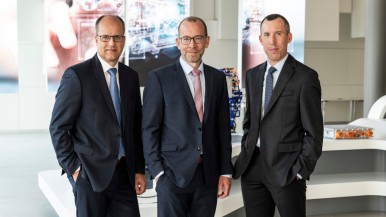The market
- In 2020, some 440 billion dollars’ (385 billion euros) worth of semiconductors were sold worldwide, an increase of around 7 percent over 2019 (source: World Semiconductor Trade Statistics [WSTS]). WSTS estimates that the market will grow roughly 11 percent in 2021, to 488 billion dollars (427 billion euros).
- In 2020, the European semiconductor market was worth 38 billion dollars (33 billion euros), with 12.3 billion dollars (10.8 billion euros) of this amount accounted for by Germany (source: ZVEI). ZVEI expects sales across Europe to grow 5 percent in 2021, to roughly 40 billion dollars (35 billion euros).
- In 2020, semiconductors for automotive applications accounted for 10.6 percent of the global semiconductor market. In the EMEA semiconductor market, these chips have a market share of 35 percent (source: ZVEI, WSTS).
- Since 2009, micro- and nanoelectronics has been one of Europe’s six key enabling technologies (KETs). The European Commission regards these technologies as decisive for Europe’s future competitiveness.
- Bosch is one of the leading manufacturers of semiconductors for automotive applications. It is also one of the leading companies for the manufacture of MEMS sensors for automotive applications and consumer electronics.
Production
- Semiconductor chips are manufactured on circular discs of e.g. silicon or silicon carbide, known as wafers. Depending on the size of the chip, an eight-inch (200-millimeter) wafer will yield anything between a few hundred and a few thousand chips. Although the silicon chips measure just a few square millimeters, they contain complex circuits, sometimes featuring several millions of individual electronic functions.
- While three-inch (76-millimeter) wafers were standard in the 1970s, most of the wafers produced today are either 8 inches (200 millimeters) or 12 inches (300 millimeters) in diameter. Bigger wafers mean that more chips can be produced in one manufacturing cycle.
- Semiconductor production is carried out under cleanroom class 1 conditions. Every cubic foot (approx. 28 liters) of normal ambient air contains 100,000 particles. When manufacturing semiconductors, by contrast, there must be no more than one particle weighing half a microgram in every cubic foot of air. That is roughly the equivalent of having a single cherry pit in all of Lake Constance.
- The process of turning raw wafers into semiconductor chips is a complex one, and can last up several month.
- In 1994, Bosch developed the “Bosch process” for manufacturing MEMS sensors. For this work, the developers Jiri Marek, Michael Offenberg, and Frank Melzer received the German Future Prize in 2008.
- Bosch holds more than 1,500 patents and patent applications in the field of semiconductors, 1,000 of which are for MEMS technology.
The development of semiconductor technology at Bosch
- Bosch has been manufacturing a wide range of semiconductor chips for more than 60 years. These include application-specific integrated circuits (ASICs), power semiconductors, and microelectromechanical systems (MEMS).
- In the mid-1950s, Bosch research began to explore the development of particularly robust semiconductor components that are suitable for use on the road.
- In the 1960s, Bosch developed the first power semiconductor for cars. Back then, special generator diodes made generators more reliable and longer-lasting.
- At the end of the 1960s, Bosch built its first semiconductor factory in Reutlingen due to the growing demand for the components from within the Bosch Group. Production of integrated circuits started 1970.
- In 1970, Bosch launched the world’s first mass-produced ASICs for cars. Specifically, they were power transistors for voltage regulators and integrated circuits.
- When Bosch began producing its Motronic – a digital engine control system (ignition and injection in one control unit) – in 1979, it had an eight-bit microprocessor on board. Together with the erasable memory used, this was effectively the world’s first use of a computer in a car in a driving-relevant role.
- Bosch has been producing MEMS sensors for more than 25 years; the first model was a pressure sensor for the Bosch Motronic.
- In 2010, Bosch took its 200-millimeter semiconductor factory in Reutlingen into operation. With a total outlay of 600 million euros, this was the biggest single investment ever made in the company’s history.
- In June 2018, Bosch laid the foundation stone for the construction of one of the world’s most advanced semiconductor factories: starting in 2021, it will produce semiconductor chips based on 300-millimeter technology. Bosch is investing roughly a billion euros in this high-tech plant.
Use in vehicles
- Worldwide, the average value of the microelectronics per vehicle will have grown from 138 dollars (120 euros) in 1998, to 559 dollars (489 euros) in 2018, to 685 dollars (600 euros) by 2023 (source: ZVEI). According to the experts, most of this growth will be due to driver assistance systems, infotainment, and powertrain electrification.
- Semiconductors account for some 80 percent of innovations in new vehicles (source: ZVEI). They can be found, for example, in the powertrain, in the cockpit, and in the infotainment and driver assistance and safety systems.
- While every car rolling off the production lines worldwide in 2016 had on average nine Bosch chips on board, this figure had risen to 17 chips by 2019.
Use in consumer and entertainment electronics
- For 15 years, Bosch MEMS sensors have also been used in consumer electronics. 2006 saw the market launch of the first MEMS sensor for this sector. It enhanced the fun of games consoles.
- In 2020, just under 1.3 billion smartphones were sold (source: International Data Corporation [IDC]). In addition, wearables – the collective term for electronics that can be worn on the body, such as smart watches, fitness armbands, and data goggles – are growing in popularity. In 2020, sales of wearables were around 445 million units (source: IDC). All these devices contain sensors that evaluate a very wide range of information.
- On average, five MEMS sensors are built into every smartphone. They enable the mini-computers to recognize when the screen has been turned, and they stabilize photos and facilitate navigation.
Amazing but true
- When Bosch began the production of micromechanical sensors in 1995, the edge length of an acceleration sensor was 133 millimeters. The edge length of the smallest MEMS sensor currently in Bosch’s portfolio is 1.56 millimeters. That is smaller than a pinhead and represents a miniaturization of the sensor size by factor 85 within about 25 years – while simultaneously featuring more functions. More than 80 of these microchips would fit on a thumbnail.
- To date, Bosch has manufactured well in excess of 15 billion MEMS sensors in Reutlingen, with several million more added to the tally every day.
- On average, Bosch semiconductors are two millimeters thick. If the 15 billion MEMS sensors already manufactured by Bosch were laid end to end, the row of chips would be about 30,000 kilometers long. That is roughly the distance from the North to the South Pole and back to the equator.
- In consumer electronics, MEMS sensors are less than one millimeter in height. Some components inside the sensors measure a mere four micrometers – 17 times thinner than a human hair.




